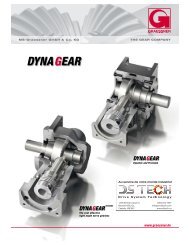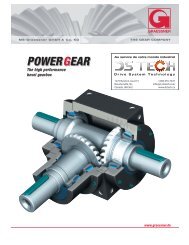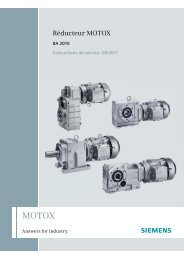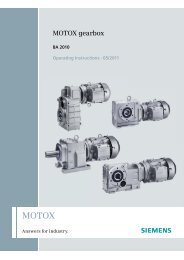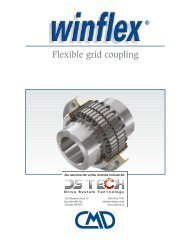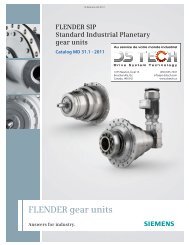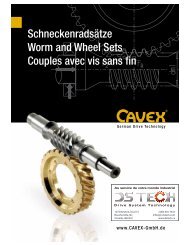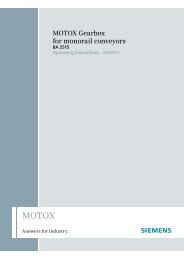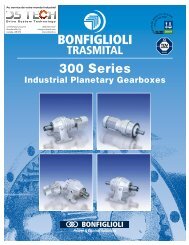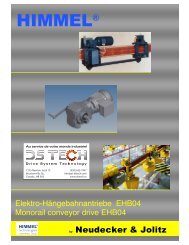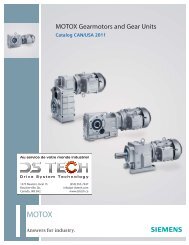FLENDER Standard Couplings - DS TECH
FLENDER Standard Couplings - DS TECH
FLENDER Standard Couplings - DS TECH
- No tags were found...
You also want an ePaper? Increase the reach of your titles
YUMPU automatically turns print PDFs into web optimized ePapers that Google loves.
<strong>FLENDER</strong> <strong>Standard</strong> <strong>Couplings</strong><br />
Fluid <strong>Couplings</strong> — FLUDEX Series<br />
Technical specifications for the selection of type<br />
and size for FLUDEX fluid couplings<br />
© Siemens AG 2011<br />
Please complete as far as possible and return to your Siemens Sales Office.<br />
1. Intended use of coupling<br />
As starting aid For overload protection For torsional vibration isolation<br />
2. Data for prime mover<br />
2.1. Electric motor characteristic enclosed<br />
Power rating P 1 = ..................... kW at speed n 1 = ..................... rpm<br />
Starting: Direct Star delta Other: ....................................................................................<br />
Motor shaft: Ø ..................... x length ..................... mm<br />
2.2. Internal combustion engine Number of cylinders: .....................<br />
Planned<br />
max. power rating: ..................... kW at ..................... rpm<br />
Operating range<br />
min. power rating: ..................... kW at ..................... rpm<br />
Attachment via shaft Ø ..................... x length ..................... mm Attachment to flywheel SAE ....................."<br />
Motor rigidly<br />
Motor flexibly installed on foundation/base frame<br />
3. Data for driven machine<br />
(450) 655-7447<br />
info@pt-dstech.com<br />
www.dstech.ca<br />
13<br />
3.1. Type of driven machine: ....................................................................................<br />
3.2. Required power rating P 2 : ..................... kW at n 2 = ..................... rpm<br />
3.3. Mass moment of inertia J = ..................... kgm 2 (based on n 2 )<br />
3.4. Operational cycle: uniform operation non uniform operation<br />
3.4.1. Starting frequency min.: 1 x / day 1 x / week 1 x / month Continuous operation (min.<br />
2 months without stopping)<br />
Starting frequency max.: < 3 x in succession Number in succession: .....................<br />
< 5 x / hour Number per hour: .....................<br />
3.4.2. Duty cycle per operational cycle: 60 - 100 % DC = ..................... %<br />
3.4.3. Dimensions of the gear unit/machine shaft on the coupling side Ø ..................... x length ..................... mm<br />
4. Ambient conditions<br />
4.1. Place of installation: < 1000 m above sea-level ..................... m above sea-level<br />
out of doors in narrow space other: .......................................................<br />
4.2. Temperature of the ambient air (cooling air): min .....................°C max ..................... °C<br />
4.3. Fitting into guard bell housing<br />
Holes: with large (well ventilated) with small (less well ventilated)<br />
without holes:<br />
with forced ventilation without forced ventilation<br />
4.4. Environment: normally dusty extremely dusty abrasively dusty<br />
4.5. Use in potentially explosive environment<br />
aggressive atmosphere: ....................................................................................<br />
in conformity with ATEX 95: || 2 G c T3 D160 °C || B -30 °C = T a = +50 °C / | M2<br />
other class: ....................................................................................<br />
5. Arrangement of coupling<br />
5.1. horizontal at an angle (max 20°) vertical: vertical:<br />
motor overhead motor underneath<br />
5.2 between: and:<br />
Motor Driven machine<br />
Gear unit (n 1 = ..................... rpm) Gear unit<br />
Transmission/belt drives Transmission/belt drives<br />
1275 Newton, local 15<br />
Boucherville, Qc,<br />
Canada, J4B 5H2<br />
13/50 Siemens MD 10.1 · 2011



